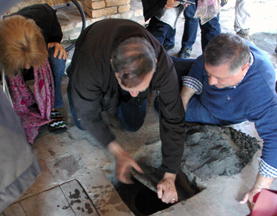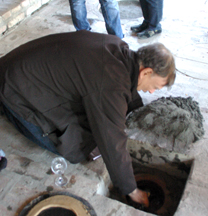 Once upon a time, thousands and thousands of years ago, earthen vessels resembling qvevri were used to bury people in a sitting position. Sealed in an earthen vessel and buried underground seems so final. However with wine, it is representative of birth.
Once upon a time, thousands and thousands of years ago, earthen vessels resembling qvevri were used to bury people in a sitting position. Sealed in an earthen vessel and buried underground seems so final. However with wine, it is representative of birth.
This is what it was like for Rkatsiteli, buried in a qvevri under the ground for the past six months. Death came to yeast cells that fell to the bottom of the qvevri. Skins and seeds fell next, but a clear wine remained on top awaiting for its birth. Yesterday, we returned to Twins Wine Cellar in Napareuli to open our qvevri. After removing black sand, the tomb’s lid was removed. At least it resembled a tomb’s lid. Held tightly to the qvevri opening by clay and suction, the lid loosened after some pressure was applied. The wine was greeted by daylight and the birth took place.
Gently stirring the wine, a glass was then filled with a tasting. The yellow colored qvevri wine was tasted for the first time. The color was clear as though the wine had been filtered. However, no filtering took place other than the natural filtering of the earthen winemaking vessel. Floral and tropical fruit aroused the nose and mouth. There was a crisp finish and mild tannins, the result of the skins and seeds contact for several months. Others in the media group attending the qvevri opening were pleased with the wine, a lighter body with less tannins than some of the amber colored qvevri white wines tasted in Georgia.
This natural wine had no winemaking supplies added to it, including commercial yeasts. Fermentation took place with the natural yeasts that were present in the vineyard. No other winemaking supplies were added. From the qvevri the wine was bottled and corked. Time will tell how well the wine will handle transportation of 6,500 miles and bottle aging prior to opening. Our first opening of a qvevri wine was a special occurrence not unlike a birth.
Cheers,
Terry




How is the wine removed from the vessel? Is the vessel removed from the ground to prepare for the following year, or is it left in the same condition for the following season?
Qvevris are meant to be buried in the ground permanently. Winery crew can climb into large capacity qvevris to clean them. Smaller qvevris are cleaned from above the ground. The cleaning that we have seen and done involve using a cherry bark brush and fresh water to rub the sides of the qvevri. The water is replaced with new fresh water and the process is repeated until the water is clear after brushing the sides. At this point we burned a sulphur strip to sanitize the interior.